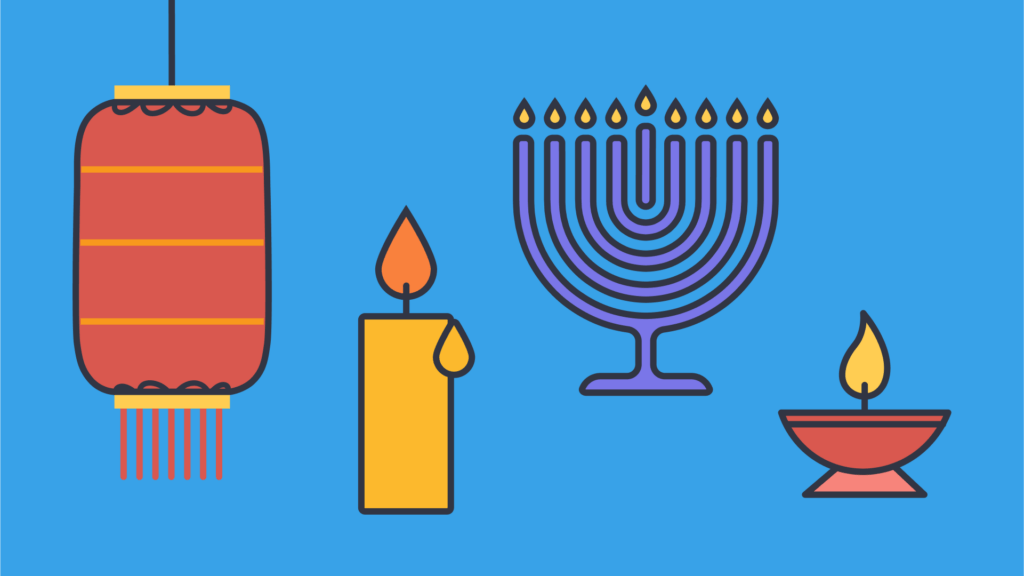Classroom activities for Hanukkah 2025, the Festival of Lights
In this guide
When is Hanukkah in 2025 and what is it about?
Hanukkah, also known as the Festival of Lights, will begin at sundown on Sunday December 14th, and ends on Monday December 22nd.
Hanukkah is celebrated to commemorate the day the Maccabees, who were a group of Jewish fighters, were victorious against the Syrian-Greeks, who had been occupying Israel.
According to Jewish history, the Syrian-Greeks had destroyed the Jewish temple in Jerusalem, and had banned anyone from practicing Judaism. After a struggle that lasted three years, the Maccabees took back control of the temple, and made it so that people could practice their faith openly again.
Hanukkah is known as the festival of lights because it is celebrated by lighting candles in a special candlestick called a Menorah, on each day of the holiday. These candles, or lights, represent the miracle of the oil burning in the temple during the revolt of the Maccabees.
During Hanukkah, gifts are given, people eat traditional foods, play traditional games, and, of course, they visit the synagogue, the Jewish place of worship.
Learn more about the Traditions of Hanukkah.

Why it’s important to include Jewish holidays in classroom learning
There are a number of reasons that you should try to learn about Jewish holidays, along with holidays of a variety of other faiths with your students.
In any classroom, it is important that we make all of our students feel heard, seen and valued. If you have any students of Jewish faith in your class, this becomes even more important, but even if you don’t, by embracing festivals and celebrations from all around the world and from a variety of different religions and denominations, you are modeling to your students that everybody is equal, and important, and worthy of celebrating.
In my very first year of teaching, I worked in an inner city school, where the class of 30 children was made up of 14 different nationalities, with almost as many religious beliefs! Some of my most memorable times from teaching that class are actually those special moments where we were learning about a place or a belief that was part of somebody’s cultural background and identity.
Joy, pride and worthiness literally shone out those children when they were able to share their beliefs and traditions with the class, and I made sure throughout the year to celebrate each and every one of them!
Learning about Hanukkah in particular will also be beneficial for all of your students, because the stories model and teach the themes of hope, perseverance, unity, and gratitude. These are themes that are common in many stories and traditions from different religions, and this allows students to see the similarities and differences, and make links between a variety of beliefs and practices.
Hanukkah-themed crafts, games, and storytelling ideas
There are so many hands-on, fun and engaging activities that you can do in your classroom when teaching about Hanukkah! In my experience, children learn best when they are having fun, so here are some fun crafts, games and other activities:
Crafts
Star of David Art
When learning about Hanukkah, your students will inevitably have questions about the Jewish faith as a whole. Why not encourage them to research the history and symbolism of the Star of David?
Once they have found out more about this symbol of Judaism, they can then create their own versions!
You may decide to encourage your students to show their creativity in a certain way, such as decorating lolly sticks and sticking them together to form a star, or maybe you will offer your students a variety of materials and resources and the freedom to create whatever they like!
Decorate a Dreidel
A dreidel is a four sided spinning top, and it’s a game that many Jewish children will play during Hanukkah.
Each side of the dreidel shows a Hebrew letter, which together form an acronym for the Jewish saying ‘a great miracle happened here’ referring to the story that Hanukkah celebrations are centered around!
Depending on the age and capabilities of your students, there are a number of ways you can organize this activity!
- Provide wooden or plastic dreidels and permanent markers, so that students can decorate the dreidels with their own patterns and designs.
- Create a net pattern or a dreidel, or find one online like this one, and your students can combine their knowledge of shape to cut out and make their own dreidels, decorating them along the way!
- Challenge your students to create their own net pattern of a dreidel, and to write their own Hebrew letters too. They can then cut these out and stick them together to make their own dreidel game.
Candle Making
After learning about how candles are used to celebrate Hanukkah, it might be fun to make some with your students!
You will need:
- Beeswax pellets,
- Cotton wicks,
- A canister and
- A saucepan of water.
You will also need a stove, and possibly a glass of water to cool down each wax layer more quickly.
Method:
- First, cut the wick to your desired length.
- Then, melt the wax in a canister or jar that is set in a pan of boiling water.
A recycled food can work well for this.
- When the wax has melted, dip your wick into the wax, then into a glass of cold water to set it.
- Repeat this process until your candles are the right width!
Why not then use these candles in your classroom Menorah over the Hanukkah period? If you and your students are feeling particularly industrious, you could make lots of candles, and sell them to your school community, raising money for a charity along the way!
Games
Dreidel game
This game has been played traditionally over Hanukkah for well over a century! Your students, whether or not they are Jewish, wil love playing this game. I have played dreidel in my classes, from any age between 5 and 11, and they all find it fun!
Essentially, you roll the dreidel, and there are different actions depending on the letter you land on.
Check out more detailed instructions here.
Hanukkah Bingo
This is a great way for your younger students especially to remember the important vocabulary about Hanukkah.
Each student should have a bingo card with up to ten images or words that are linked to Hanukkah.
For example, the boards might show images of:
- A Menorah,
- A Star of David,
- A gift,
- Some oil, The Torah,
- A Temple,
- The Maccabees,
- Judah etc.
Ideally, you’ll have a few different sets so that not all the students have the same board! Alternatively, you could show a list of possible things to go on the board and each student could make their own! I have found this to be a more engaging way to play bingo with older students.
To play the game, either call out, or, for older students, describe one of the images.
For example, you might say ‘a game played with four sided spinning top traditionally played during Hanukkah’.
The student could then cross our ‘Dreidel’ if it is on their board.
The winning students are the first to cross off 3 images in a row on their board.
Storytelling ideas
Role play
Role play is such a great way for students to embody a story they are learning.
After teaching your students about the Maccabees, encourage them to act out the story! Put them into smaller groups, and give them some props, and perhaps a brief outline of the story.
Their task is to create a piece of drama. If possible, allow time for the students to show their piece to the rest of the class! This can also be a great way for you to also assess your students in their public speaking and teamwork skills!
Hanukkah books
Another way for your students to show their understanding of the Hanukkah story is for them to make their own books that tell the story. I have had great success with even the most reluctant writers just because they have a ‘book’ to write in rather than their usual exercise books.
Create a template with space for your students to write and illustrate, and print these so that they fold up to make a book shape with pages that turn.
Younger students could create a picture book version, whilst older students could write the story in their own words and add illustrations.
Watch/listen to some stories about Hanukkah – sometimes our students need the opportunity to simply sit and listen!
Check out your local library for books all about Hanukkah, and find lots of videos in the Hanukkah Topic.

Meaningful ways to teach about the Festival of Lights
Symbolism – What does Light mean to you?
I have often found that the most memorable lessons with your students can come from the opportunities that you offer for them to share their thoughts, opinions, and ideas.
Posing a question such as ‘What does light mean to you?’ offers your students the chance to really ponder and philosophise, both skills that our busy curriculum doesn’t leave a lot of time for!
Look at other holidays that incorporate light.
As well as Hanukkah, there are other religious festivals and spiritual events that focus on light. Why not use this time to teach your students about Diwali, Vesak and Easter Sunday. These celebrations all incorporate light or have the theme of light over darkness.
Perhaps your students could create a presentation that compares and contrasts these festivals with Hanukkah?
Daily gratitude with a candle
During Hanukkah, it is important that your students realise that the festival is centered around gratitude.
Gratitude for light over darkness, and gratitude for the victory of the Maccabees .
Daily gratitude is something I LOVE to do in my classroom. At the end of the day, every student (who wants to participate – they usually all do after a few days!) says something that they feel grateful for that day.
It really encourages your students to think about their day in a positive light, and to realize how much theory actually is to be grateful for!

Encouraging cultural appreciation and classroom celebration
Whatever the demographic of your school, it is SO important to instill cultural appreciation and awareness in your students, especially if the cultures and religions you are teaching them about are not ones they are exposed to in their home environments!
Invite a Jewish speaker
I have had great success with inviting the local Rabbi into the school. They usually come with artefacts, stories, and even gifts for the students! I have students who remember their Rabbi visits from over 5 years ago!
Create a classroom display
Sometimes after learning about a particular topic, it can often be forgotten about after a few weeks. By creating a classroom display that celebrates the learning, your students are much more likely to remember their learning later on in the year.
Additionally, your entire school community can benefit if your display is somewhere that other students will get to see it!
Share your learning
After learning about Hanukkah, why not invite some students from a different class to come and join in the fun for a Hanukkah party!
This will give your students the opportunity to teach their peers about what they have been learning about, as well as to have fun, eating some traditional foods and playing traditional games.
Hanukkah 2025 is a really special opportunity for you to introduce your class to this exciting celebration, whatever their religious denomination or cultural background. Introducing your students to a variety of cultures and religions, and embracing these equally and without judgement, can model acceptance, tolerance and understanding of people from all backgrounds.

Ruth Litchfield
briefcase iconEducator & Education Content Creator
Ruth is an experienced primary school educator of over a decade, and an Educational Content Creator. She specialises in creating fun and engaging activities that require minimal resources and cover multiple curriculum areas.
Other posts
Want more content like this?
Subscribe for blog updates, monthly video releases, trending topics, and exclusive content delivered straight to your inbox.












